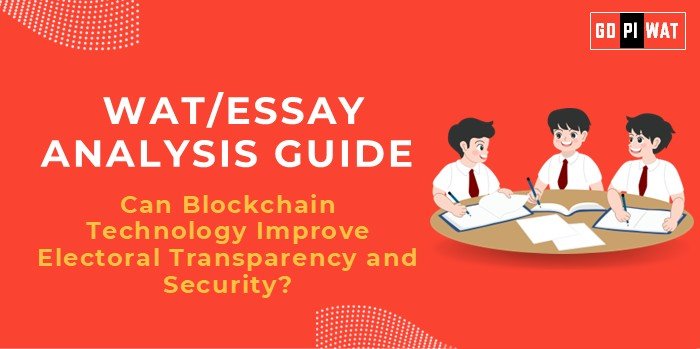📋 Written Ability Test (WAT)/Essay Analysis Guide: Can Blockchain Technology Improve Electoral Transparency and Security?
🌐 Understanding the Topic’s Importance
The role of technology in governance is critical, particularly in democracies where trust in electoral systems underpins legitimacy. Blockchain’s ability to ensure secure, transparent, and tamper-proof records aligns perfectly with these goals.
📑 Effective Planning and Writing
- ⏱️ Time Allocation:
- Reading & Planning: 5 minutes
- Writing: 20 minutes
- Review: 5 minutes
- 📋 Preparation Tips: Gather key data points, global examples, and SWOT analysis.
💡 Introduction Techniques for Essays
- Contrast Approach: “While blockchain is heralded as the next frontier in electoral integrity, questions remain about its scalability and inclusivity.”
- Solution-Based Approach: “The integration of blockchain technology in elections could bridge the trust gap plaguing global democracies.”
📋 Structuring the Essay Body
- 🏆 Paragraph 1: Achievements
- Immutable and transparent records.
- Cost-effectiveness of digital systems over time.
- ⚠️ Paragraph 2: Challenges
- High costs and digital divide.
- Case study of Estonia’s early hurdles in e-voting.
- 🌟 Paragraph 3: Future Outlook
- Addressing cybersecurity risks through quantum cryptography.
- Leveraging blockchain for inclusive governance models.
📄 Concluding Effectively
- Balanced Conclusion: “Blockchain offers immense promise but requires addressing systemic challenges for successful integration.”
- Global Comparison Conclusion: “Estonia’s success in e-governance highlights the need for robust frameworks to ensure blockchain’s effective deployment in elections.”
🚀 Recommendations for Sustainable Progress
- 🔒 Investment in cybersecurity.
- 📋 Pilot projects to test inclusivity.
- 📢 Public awareness campaigns for digital literacy.
📋 Sample Short Essays
- Balanced Perspective:
“Blockchain technology can revolutionize electoral systems by providing transparent and secure voting mechanisms. However, significant barriers such as the digital divide and cybersecurity risks must be addressed.”
- Solution-Oriented:
“By combining blockchain with robust cybersecurity protocols and digital literacy programs, countries can enhance trust and participation in electoral systems.”
- Global Comparison:
“Estonia’s blockchain-powered e-voting showcases the potential of this technology, but its success requires significant investments in infrastructure and security.”
📄 Source: WAT and GD preparation frameworks, 2024.


